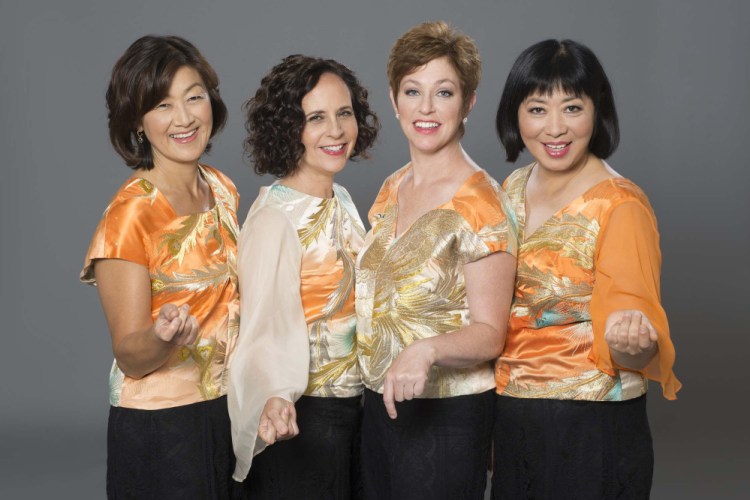The Seal Bay Festival is one of the most interesting and unusual of coastal Maine’s summer festivals, focusing as it does on contemporary American chamber music and encouraging associations between music and the visual arts. It maintains a strangely low profile, possibly because of its essentially itinerant nature. Instead of setting up in a specific place and expecting listeners to make their way there, Seal Bay travels from town to town – Portland, Brunswick, Waterville, Yarmouth, Belfast and Vinalhaven, this summer – presenting concerts in galleries, hospitals and museums.
One of its regular stops is Space Gallery, where the festival’s resident ensemble, the Cassatt String Quartet, played works by six composers on Thursday evening, three with strong Maine associations. One was Elliott Schwartz, the state’s best-known composer, who died last year; the others were Vineet Shende, the chair of Bowdoin College’s music department, and Peter McLaughlin, an eclectic composer and percussionist who studied with Schwartz and oversees the music programming at Space.
Muneko Otani, the Cassatts’ first violinist, opened the program with Shende’s solo violin work, “Prakash Ani Saoli,” a Marathi title meaning “Luminescence and Shadow.” As its title implies, it is packed with oppositions, its luminescence and shadow first taking form as bowed and pizzicato passages, and then as a stream of contrasting dynamics, coloration and techniques.
Mostly, though, you forget about the title and its philosophical underpinning (Shende, in a pre-concert panel discussion, explained that you cannot understand light unless you also understand darkness and vice versa), and you hear the work as a dazzling showpiece that draws on just about anything a solo violinist can do – single lines, both angular and lyrical, as well as chordal passages, arpeggiated themes, repeating scale figures, left-hand pizzicato to add texture while the main line is bowed – without becoming a mere catalogue work. Otani played it engagingly, making a case for it as a substantial addition to the repertory for unaccompanied violin.
The program’s only other solo work was McLaughlin’s “No Sad Songs (for Elliott),” a tribute to Schwartz for unaccompanied viola, played with energy and gracefulness by Ah Ling Neu. In his program note, McLaughlin described the piece as “simply a vignette,” but he is selling himself short. The viola line begins as a plaintive voice, swathed in a resonant ambience that slowly becomes a full-fledged electronic soundtrack. The electronics ebb and flow, swamping the viola at times, working as a textural backdrop elsewhere, and providing a constantly changing palette throughout.
Both the Shende and McLaughlin works had their world premieres at the festival’s Belfast concert on Wednesday.
Schwartz was represented by his String Quartet No. 3, “Portrait (for DeeDee),” a tribute to his wife, the visual artist Dorothy Schwartz, composed shortly after her death in 2014.
The performance was listed as the work’s United States premiere. Not so. The Portland String Quartet played it at the Portland Conservatory’s Back Cove Contemporary Music Festival in April. But it was great hearing it again (and to see a broad selection of DeeDee’s inventive artworks, projected on a screen behind the ensemble). Built partly on notes derived from DeeDee’s name and with brief snippets of the couple’s favorite works wafting through the texture, this is a tender, rich-hued piece in which humor mingles with an understated sense of loss, all bound together in warm, consonant textures.
Victoria Bond‘s “Dreams of Flying” (1994) and Augusta Read Thomas‘ “Helix Spirals” (2015) both use the string quartet in picturesque ways. Bond’s four-movement score turns the ensemble into a flying machine, its music lifting slowly upward (by way of a simple two-note figure that rises in pitch through the first movement) before finding its cruising altitude, and then exploring a handful of fantasy scenarios, including one inspired by “Gulliver’s Travels.”
Thomas’s piece is inspired by the structure of DNA and creates fascinating imagery through its use of full-ensemble pizzicato in the first movement and attractively interwoven, slowly swirling themes through its other two movements.
The Cassatt players – Otani and Neu, with violinist Jennifer Leshnower and cellist Elizabeth Anderson – gave colorful readings of both works, as well as the program’s final piece, the brief, propulsive “Intermedio” (1986) by Daniel Strong Godfrey, the festival’s founding director.
Allan Kozinn is a former music critic and culture writer for The New York Times who lives in Portland. He can be contacted at:
allankozinn@gmail.com
Twitter: kozinn
Send questions/comments to the editors.



Success. Please wait for the page to reload. If the page does not reload within 5 seconds, please refresh the page.
Enter your email and password to access comments.
Hi, to comment on stories you must . This profile is in addition to your subscription and website login.
Already have a commenting profile? .
Invalid username/password.
Please check your email to confirm and complete your registration.
Only subscribers are eligible to post comments. Please subscribe or login first for digital access. Here’s why.
Use the form below to reset your password. When you've submitted your account email, we will send an email with a reset code.